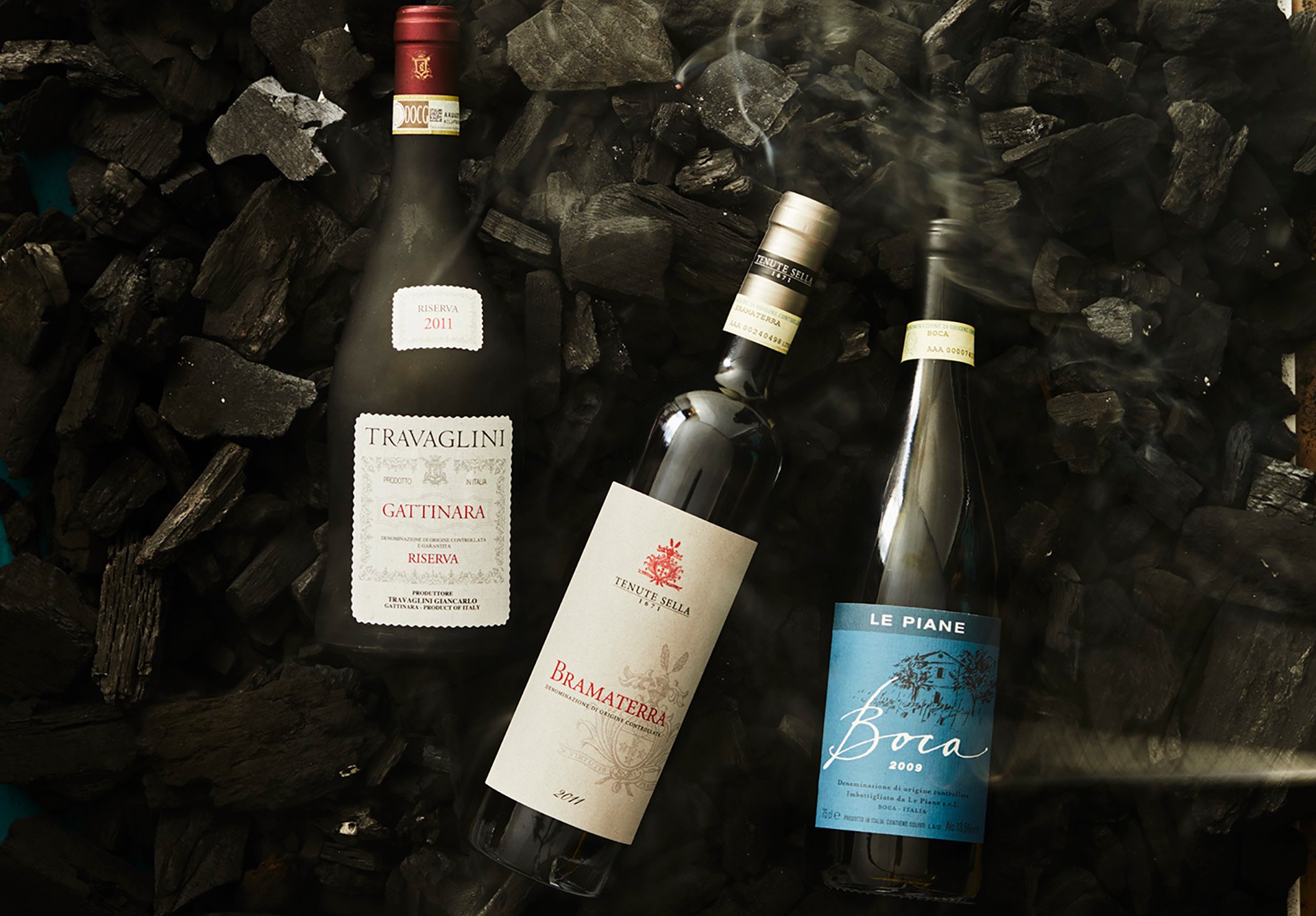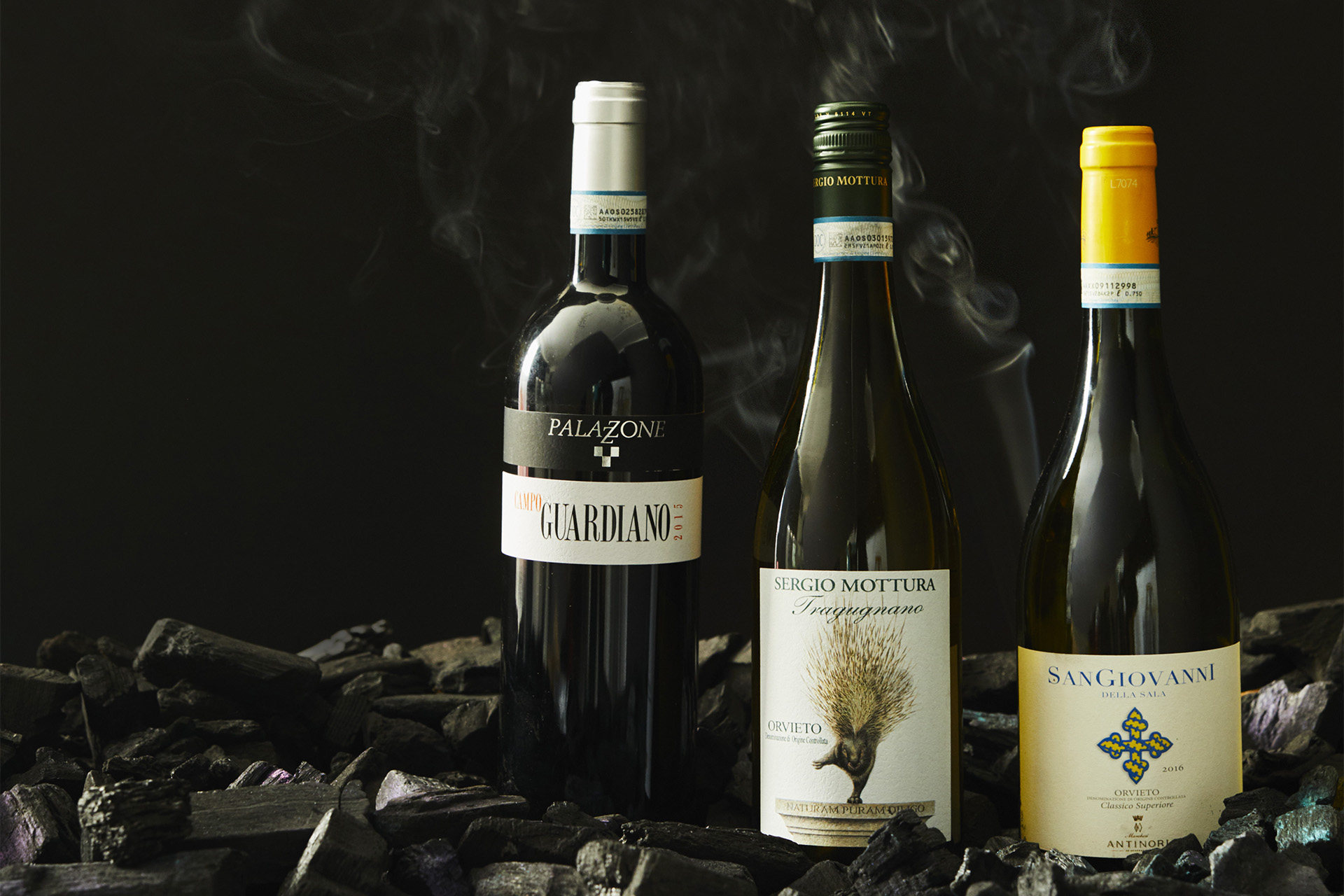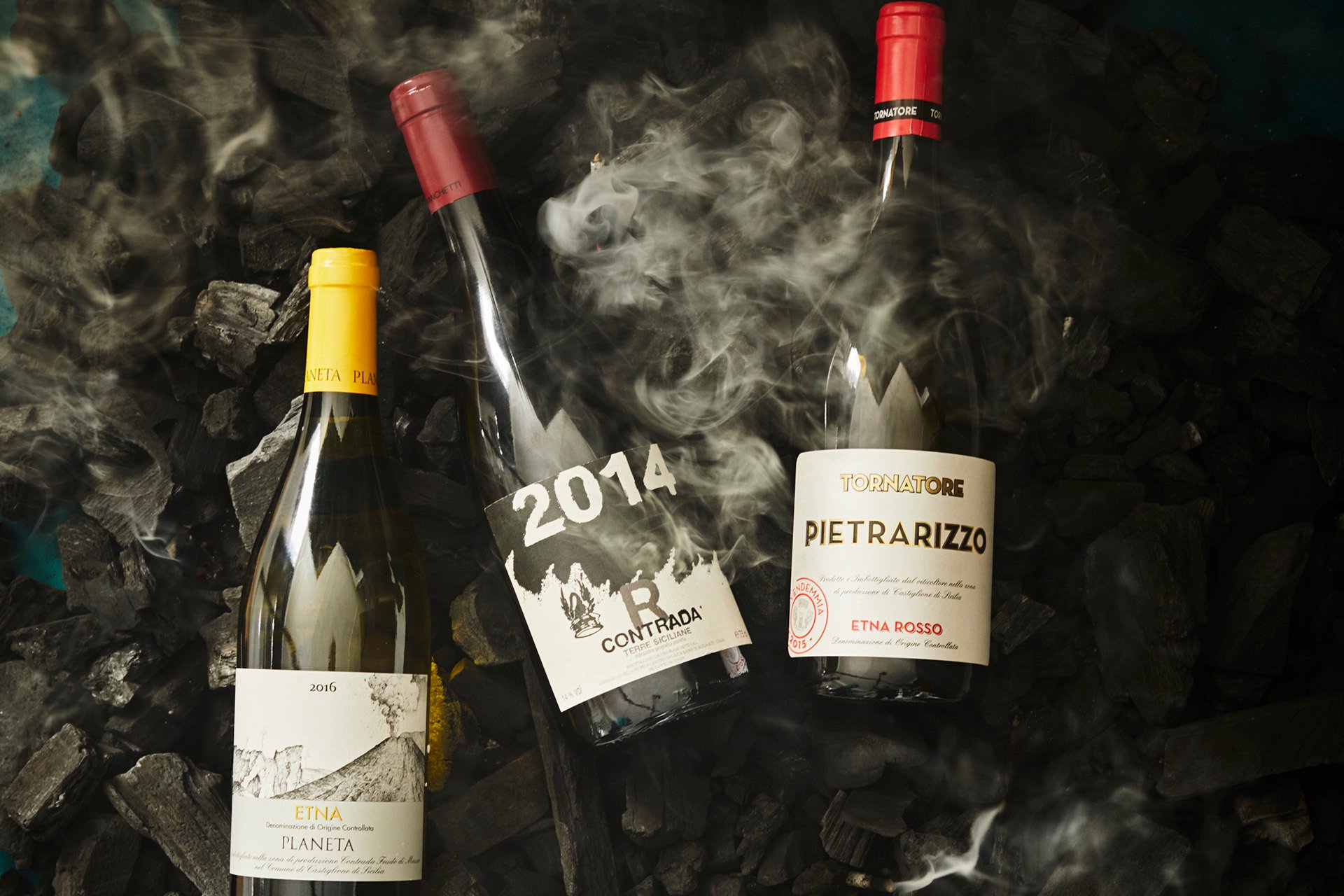
© Paolo Tenti | working Ciro Biondi’s vineyard on Mt. Etna
Some of the most exciting and intriguing wines coming out of Italy have one thing in common: the volcanic origins of their soils. While the wines of Mount Etna immediately pop to mind, a surprising number of great wines, from the Veneto down to Sicily, hail from volcanic terroirs.
And while minerality is one of the most debated subjects in the wine world, Italy’s volcanic soils impart undeniable mineral sensations that include flint, crushed rock and saline, lending depth and complexity to the resulting wines.
Additionally, many of these grape-growing areas have extremely old vines, some more than 100 years old in parts of Campania and Sicily. And nearly all of the “volcanic” denominations rely on native varietals that have had centuries to adapt to their growing conditions.
The vineyard altitude, grape varieties and cellar practices all play crucial roles in the final product, but volcanic soils lend structure, longevity and an extra layer of dimension to the final wines. Here’s where to find these complex beauties.
The full article will be published in the February 2018 issue, but it is already available online: The Volcanic Wines of Italy
Campania
Campania is a captivating and beautiful region in the southwest of the country. It’s also home to two of the most dangerous volcanoes in the world: Mount Vesuvius and Campi Flegrei, situated on either side of Naples.
Mount Vesuvius, to the east of Naples, last erupted in 1944 but is better known for burying Pompeii under up to 20 feet of volcanic ash and pumice in 79 A.D. Vesuvius’s violent eruptions are also responsible for the volcanic soils found in the growing zones of Irpinia, about 30 miles away.
Irpinia is home to native red grape Aglianico, most notable in Taurasi, and white grapes Fiano and Greco di Tufo. While these varieties grow in other areas, they produce savory wines of exceptional longevity here.
Fiano di Avellino produces full-bodied white wines, with floral aromas, rich fruit flavors and smoky mineral sensations. The best have great intensity and complexity. Unlike Campania’s other native white grapes, Fiano has spread to additional regions, where it yields rounder wines with more tropical fruit sensations. Still, hilly Irpinia is the grape’s spiritual home.
“Fiano excels here, thanks to high rainfall, dramatic day and night temperature swings and the soil: volcanic soils and clay deposits,” says Pierpaolo Sirch, agronomic and cellar operations supervisor at Feudi di San Gregorio.
Greco di Tufo, named after the tiny town of Tufo in the province of Avellino, stands alongside Fiano as one of Southern Italy’s most noble white grapes.
A clone of Greco Bianco, Greco di Tufo thrives in its namesake denomination due to its cool climate, frequent rainfall and volcanic soils. The wines have crisp acidity, flinty minerality and intense aromas and flavors that include peach and citrus. They’re chock-full of complexity and finesse.
Campania’s flagship red wine, Taurasi, also hails from the hills around Avellino. Often called the “Barolo of the South,” Taurasi wines are typically full-bodied and full of flavors that evoke red cherry, dark spice, menthol and mineral sensations, all set in a powerful, ageworthy structure.
“We have about two meters of friable, ashy topsoil in our vineyards,” says Antonella Lonardo, who assists her father at their Contrade di Taurasi-Cantine Lonardo firm. “Aglianico planted in these soils produces more structured wines with more pronounced tannins and acidity when compared to Aglianico grown in clay or sandy soils.”
Lonardo’s vines, which range from anywhere between 20 to 100 years old, generate a natural concentration of flavors, and they have a number of pre-phylloxera, ungrafted vines.
Composed of a network of craters and other still-active volcanic structures that are largely submerged in the Bay of Naples, Campi Flegrei lies just west of Naples. Volcanic activity is a way of life here, where the smell of sulfur permeates the air and residents are used to the feel of frequent seismic activity. It’s home to intriguing wines made with ungrafted native grapes like Falanghina.
There are two distinct clones of Falanghina: Falanghina Beneventana, used in Falanghina del Sannio, and Falanghina Flegrea, grown in Campi Flegrei. While Sannio produces more structured wines, Campi Flegrei’s offerings are linear and lighter in body.
They exhibit floral aromas and notable saline minerality, thanks to sandy, volcanic soils and vicinity to the sea.
“Our soils have two main components: sand derived from our close proximity to the sea and a mix of ash, pumice and lapilli,” says Vincenzo Di Meo, co-owner of his family’s La Sibilla estate. “Unlike the slopes of Vesuvius or Etna, we don’t have lava formations, but very loose, fertile soil resulting from recent volcanic activity.”
The family’s vines are, on average, 60–85 years old, though some extend back 200 years.
“Because of the sand, phylloxera didn’t get here, so our vines are ungrafted,” says Di Meo. “The roots go deep down, producing grapes rich in potassium and salt.
Campania
- Contrade di Taurasi – Lonardo 2011 Vigne d’Alto (Taurasi) 94 Points
- La Sibilla 2015 Falanghina (Campi Flegrei) 89 Points

From left to right: Feudi di San Gregorio 2016 Fiano di Avellino; Cantine di Marzo 2015 Franciscus (Greco di Tufo); Contrade di Taurasi–Cantine Lonardo 2011 Vigne d’Alto (Taurasi); La Sibilla 2015 Falanghina (Campi Flegrei); Mastroberardino 2009 Naturalis Historia (Taurasi) / Photo by Con Poulos
Veneto
The volcanic activity that forged the area ended millions of years ago, but Soave, named for the picture-perfect medieval town at the center of production, still offers a great example of wines made from its soils.
Only parts of the Soave denomination claim this volcanic makeup, however, namely select slopes in Soave and Soave Classico (the original growing zone). There, steep hillside vineyards have dark-colored soils consisting of basalt and tuffaceous rocks. The grape-growing areas on the plains consist of silty clay or limestone soils.
Soave’s hills demonstrate how soils influence the area’s flagship grapes, Garganega and Trebbiano di Soave, and their wines. Generally speaking, Soaves that originate in volcanic soils are more vibrant, precise and full of finesse.
“The combination of volcanic soils and native grapes Garganega and Trebbiano di Soave generates elegant wines, loaded with freshness, mineral and floral sensations,” says producer Andrea Pieropan, of the historic Pieropan family winery.
Its stunning, single-vineyard Calvarino Soave Classico is made from 70% Garganega and 30% Trebbiano grown in volcanic soils. Pieropan also makes another single-vineyard Soave Classico, La Rocca, entirely from Garganega grown in chalky clay soils. La Rocca is more structured and fruit-driven than Calvarino, but similarly compelling. Vertical tastings show that both wines boast remarkable longevity.
The Lessini Durello denomination, home to vibrant, mineral-driven metodo classico sparkling wines, is another testament to the area’s volcanic terroir.
Overlapping the Soave denomination to the east of the Classico area and spreading into the Vicenza province, the growing zone comprises high hills of purely volcanic origin. Monte Calvarina, an ancient volcanic cone near the town of Roncà, is the historic growing area for native grape Durella.
“Durella, a unique indigenous variety, grows only in this area, because it needs infertile, volcanic soil, high altitude and southern exposure,” says Antonio Fattori, owner and enologist of the Fattori winery.
- Pieropan 2015 Calvarino (Soave Classico) 96 Points Cellar Selection
- Prà 2015 Staforte (Soave Classico) 92 Points Editors’ Choice
-
Fattori 2011 Roncà 60 Non Dosato Metodo Classico (Lessini Durello) 92 Points
 From left to right: Pieropan 2015 Calvarino (Soave Classico); Prà 2015 Staforte (Soave Classico); Fattori 2011 Roncà 60 Non Dosato Metodo Classico (Lessini Durello) / Photo by Con PoulosPiemonte
From left to right: Pieropan 2015 Calvarino (Soave Classico); Prà 2015 Staforte (Soave Classico); Fattori 2011 Roncà 60 Non Dosato Metodo Classico (Lessini Durello) / Photo by Con PoulosPiemonteIn the Alpine foothills of northern Piedmont, Alto Piemonte is one of the most fascinating areas in Italy. Home to noble grape Nebbiolo as well as native grapes Vespolina, Croatina and Uva Rara, the area produces vibrant, fragrant and structured reds known for elegance and longevity.
Alto Piemonte’s five main denominations—Lessona, Gattinara, Ghemme, Boca and Bramaterra—have higher vineyard altitudes and cooler temperatures than their more famous southern neighbors, Barolo and Barbaresco.
But it’s the soils that are unique. Lessona has bright yellow, mineral-rich soil of marine origin, while Boca, Gattinara and Bramaterra have different proportions of porphyritic soils deposited by the eruptions from an ancient, long-extinct supervolcano.
“It’s one of the oldest volcanoes in the world, with origins dating back 300 million years ago,” says winemaker Daniele Dinoia, owner of the Centovigne Castello di Castellengo estate near Biella. “The eruptions not only deposited volcanic rock in some areas, but its violent volcanic and tectonic activity lifted and rotated the earth’s crust, impacting nearby areas, which explains the presence of the unique, yellow Pliocene marine sands in and around Lessona.”
Dinoia says that the winery’s vineyards in the Coste della Sesia denomination (which includes Lessona and Gattinara) have a mix of marine sands, clay and gravel. Soils in Boca, on the other hand, are entirely volcanic.
“It’s all rock here, porphyry of volcanic origin that’s ground to fine gravel on the surface,” says Christoph Kuenzli, owner of Le Piane winery. “Thanks to the soil’s low pH, the mineral sensations follow through to the grapes and are imparted to the wines.”
Gattinara also has iron-rich porphyry, while parts of Bramaterra share Lessona’s yellow sand. Other parts are dominated by volcanic rock.Marco Rizzetti, managing partner and the 11th generation to run storied Tenute Sella, says there’s a difference between its wines from Lessona and those from the rocky vineyards of Bramaterra.
“Lessona is like a classy, elegant signora, while Bramaterra is masculine, like a rugged mountaineer,” he says.
- Le Piane 2009 Boca 95 Points Editors’ Choice
-
Tenute Sella 2011 Bramaterra 90 Points

From left to right; Travaglini 2011 Riserva (Gattinara); Tenute Sella 2011 Bramaterra; Le Piane 2009 Boca / Photo by Con Poulos
Umbria/Lazio
Perched on a high volcanic bluff in southwestern Umbria, Orvieto is one of the most beautiful ancient Italian cities. It’s also the name of one of the country’s most famous white wines, Orvieto, a denomination that overlaps from Umbria into Lazio.
The town’s history stretches back to the Etruscans, who dug deep caves and a labyrinth of long tunnels in the tuffaceous rock beneath the town. Orvieto’s unique growing zone was formed from the former volcanic complex of the Vulsini Mountains during the Pleistocene epoch, most notably because of the volcano that created nearby Bolsena Lake.
Fallout from massive volcanic eruptions once covered the entire region, but over the course of millennia, only select parts of the growing area now have volcanic soils.
Orvieto’s array of soils includes tuffaceous zones of volcanic origin to the south, clay in the center, sandy with marine fossils in the northeast and silty alluvial soil along the Paglia River.
“Vineyards closer to Lake Bolsena, a crater lake, have predominantly volcanic soils,” says winemaker Sergio Mottura, whose vineyards in the southern part of the denomination are located in Lazio. “Thanks to the soil, our wines are different from others. They’re more structured, more flavorsome and have salty sensations.”
Farther north, Giovanni Dubini, co-owner of Palazzone, has mostly sedimentary clay soil of marine origin, though the highest point of one of his vineyards is interspersed with tuffaceous soil.
“Some of the grapes from this part of the vineyard go into our Orvieto Classico Superiore Campo del Guardiano,” says Dubini. “Grapes from this plot deliver a purer expression and make wines with more longevity.”
Orvieto, Orvieto Classico (the original growing area) and Orvieto Superiore (more structured) must be made from a minimum of 60% Procanico and Grechetto. There are several types, which range from dry (secco) to sweet (dolce) as well as a Muffa Nobile (noble rot, or botrytized) version.
- Palazzone 2015 Campo del Guardiano (Orvieto Classico Superiore) 93 Points Editors’ Choice
- Marchesi Antinori 2016 Castello della Sala San Giovanni della Sala (Orvieto Classico) 93 points
- Sergio Mottura 2016 Tragugnano (Orvieto) 90 points

From left to right: Palazzone 2015 Campo del Guardiano (Orvieto Classico Superiore); Sergio Mottura 2016 Tragugnano (Orvieto); Marchesi Antinori 2016 Castello della Sala San Giovanni della Sala (Orvieto Classico) / Photo by Con Poulos
Etna
No mention of volcanic wine regions would be complete without Mount Etna. The tallest active volcano in Europe, Mount Etna’s pristine wines should put to rest any debate that perceptible minerality is a myth. Made primarily with Nerello Mascalese, Etna’s reds boast the finesse of top Burgundy and the complexity of Barolo, while the whites, made predominantly from Carricante, boast unfettered purity and radiance.
Located in northeastern Sicily, Mount Etna benefits from double the rainfall and cooler temperatures than the rest of the island, as well as intense sunlight. Etna has the highest vineyard elevations in Sicily, some of the highest in all of Italy, growing at 1,300 to more than 3,900 feet above sea level. This elevation generates marked day and night temperature changes.
These unusual growing conditions play an important role, but the driving force behind Etna’s wines is its volcanic soils, which range from basalt pebbles and pumice to black ash. Etna’s contrade (the local name for crus or single vineyards) are delineated by the volcano’s lava flows, and each one of these distinct crus translates into the wines.
Alessio Planeta, co-owner of his family’s winery that has estates across the island, asserts Etna’s vineyards give a whole new dimension to the term “terroir.”
“I’ve never seen any soils as variable as those on Etna,” says Planeta. “While many of the world’s great crus have been delimited as a result of geology, on Etna, soil composition is a direct consequence of eruptions, which determines how much ash or lava the soil contains. And because Etna erupts on average 14 times a year, the soil composition transforms constantly.”
Most producers were drawn to Etna for its sleek, fragrant reds, but for Planeta, who has also planted a small amount of Riesling, it was the whites. “I love their crystalline character that combines fruit and flinty mineral notes,” he says.
-

From left to right: Planeta 2016 Bianco (Etna); Passopisciaro 2014 Contrada R (Terre Siciliane); Tornatore 2015 Pietrarizzo Rosso (Etna) / Photo by Con Poulos
Antinori Boca Bramaterra Campania Cantine di Marzo Etna Fattori Feudi di San Gregorio Franchetti Gattinara Italian wine La Sibilla Le Piane Lessini Durello Lonardo Mastroberardino Orvieto Palazzone Passopisciaro Pieropan Planeta Prà Sella Sergio Mottura Sicily Soave Tornatore Travaglini Unbria vino italiano volcanic wines
Last modified: February 13, 2024







